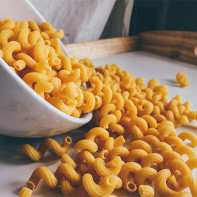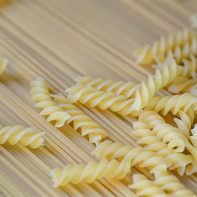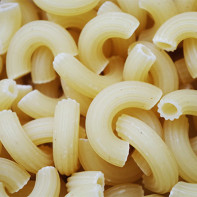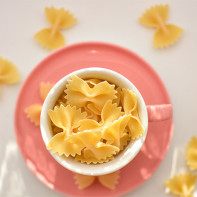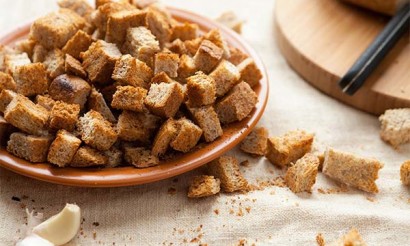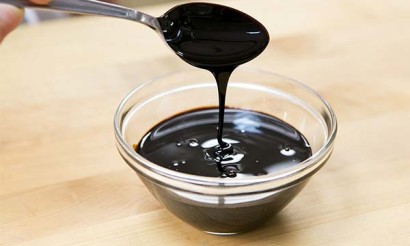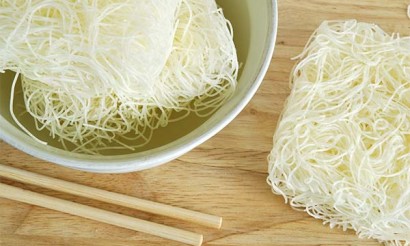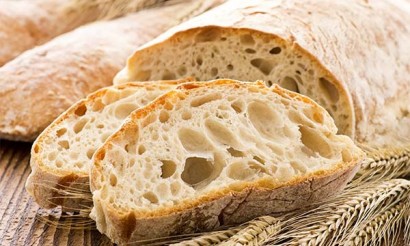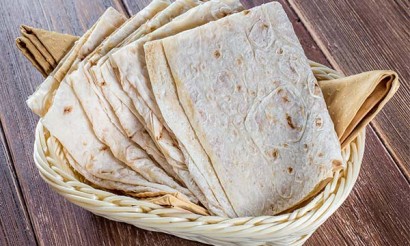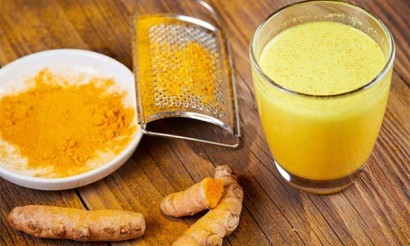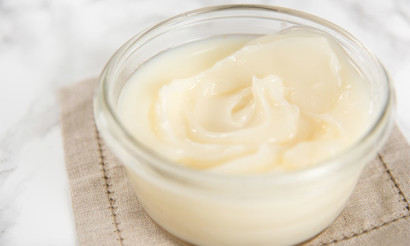Pasta: useful properties and recipes
Pasta is one of the most popular products on the tables of not only Italians, but also Slavs. What is the reason for such a demand for this product? Does it really carry nutritional value, or are there conditions under which its consumption should be abandoned?
- Types of pasta
- What is the difference between pasta and pasta
- Composition and calories
- What is useful for pasta
- General benefits
- For Women
- For Men
- When pregnant
- For breastfeeding
- For Kids
- The benefits of spelt pasta
- Is Pasta Made of Buckwheat Flour Useful
- Useful properties of pasta made of corn flour
- Is it possible to eat pasta while losing weight
- Pasta in medicine
- Diabetes Mellitus
- For pancreatitis
- Gastritis
- For constipation
- With gout
- For colitis
- For hemorrhoids
- For cholecystitis
- At poisoning.
- Harm and Contraindications
- How to choose and store the pasta
- Can I Freeze It
- How to Eat Pasta Properly
- How Often Can I Eat Pasta?
- Can I Eat Pasta at Night
- What does pasta go well with?
- How to cook pasta properly
- With minced meat
- With cheese
- With stew
- With vegetables
- With mushrooms
- How to cook
- How to cook in a multicooker
- How to cook in the oven
- Can I fry it?
- Should the pasta be washed after boiling?
- How to Make Pasta at Home
- Can animals be given pasta
- Interesting facts about pasta
Pasta Types
This product varies by the type of flour from which it is made, as well as by shape. The most often used division into pasta from durum wheat, white, buckwheat, corn flour and spelt products.
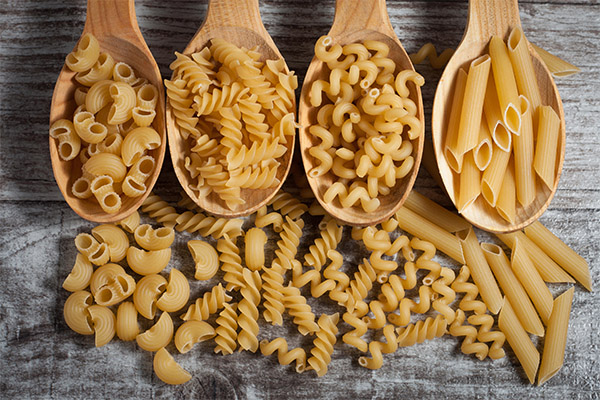
They are long straight, rounded or flat pasta, twisted, hollow products, geometric and other shapes.
In Italy, products with different fillings are also very popular.
What is the difference between pasta and pasta
The secret of the slimness of Italians who eat pasta in incredible quantities and at the same time do not gain weight is that it is made exclusively from durum wheat. Pasta is made using glassy flour, which contains far more starch and less gluten than pasta.
Recently, many pasta producers have sought to bring their products closer to their Italian counterpart by adding some durum flour to the raw materials. This slightly increases the quality of the products on store shelves, but they still differ significantly from pasta.
Pasta can be distinguished by the golden yellow hue of the products, as well as the composition indicated on the package. Only products made from water with quality flour (DurumSemolina) can claim to be called pasta. The exception are products colored with natural dyes, whose color can range from green to dark burgundy. Pasta, on the other hand, is paler and has a more varied composition.
Higher-quality products can be identified by a marking on the packet in the form of the letter "A" or the designation "1st grade. Harder varieties will also have a firmer and smoother texture.
Composition and calories
The energy value of pasta directly depends on the ingredients from which it is made.
On average, 70% of all substances in this product are carbohydrates, the rest is water and all kinds of additives (in some kinds).
Classic solid products have a caloric value of about 350 kcal (per 100 g). But if impurities such as oats, lentils, and flours other than wheat are used in the manufacture of pasta, the nutritional value can vary considerably.
Boiled pasta contains twice as many calories as raw pasta. Perhaps that is why in Italy it is customary to cook pasta "al dente" (semi-raw).
It is noteworthy that the usual pasta "flotsky" with minced meat contains about 700-800 kcal per 1 serving.
The amino acid tryptophan, contained in durum wheat used to make pasta, is valuable. They also contain a large number of vitamins, in particular B group, E and nicotinic acid, as well as minerals such as manganese, iron, potassium, phosphorus and others.
What is pasta good for?
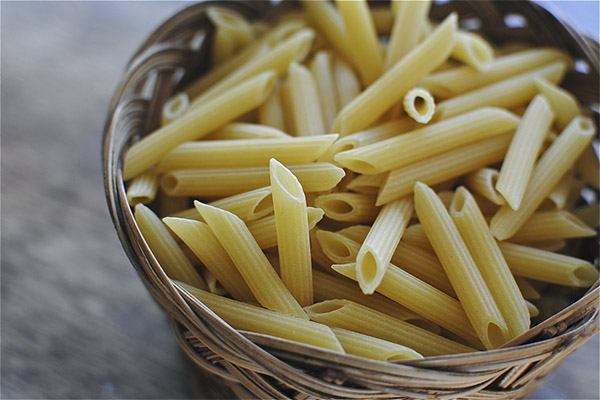
General Benefits
- The main useful ingredient of this product is fiber. Its usefulness lies in the fact that it helps to eliminate toxins from the body and free the intestines.
- Due to its rich carbohydrate composition, durum wheat pasta is excellent for providing satiety for a long period of time. This is why they are often eaten by athletes and people with active lifestyles.
- The tryptophan amino acid contained in pasta promotes fast recuperation, relaxation and a better sleep.
For women
Women's bodies perceive pasta in a special way. This is due to the high levels of the hormone oestrogen, which promotes the storage of fat when consuming flour products. Therefore, in the diet of women pasta should be present in moderate amounts.
In addition, women who consume large amounts of this product are more likely to experience vascular disease and heart problems.
For men
Men's bodies are able to excrete mainly carbohydrates. Therefore, to maintain energy levels, men are recommended to consume pasta.
When pregnant
Women in the position should carefully select their diet. Pasta can be present on the table of a pregnant woman, but only if it is made of whole grain. Such a product promotes normal peristalsis of the stomach and intestines. But in the third trimester it is better to refuse them, as they increase the risk of constipation. Colored products are not recommended for use by women in the position, because dyes can have an unpredictable effect on the body, which undergoes enormous hormonal changes.
When breastfeeding
Nutritionists note pasta as a mandatory product in the diet of a breastfeeding mother. This meal not only replenishes carbohydrates, but also provides vitamins and minerals to both mother and child through the milk. That said, there are a number of caveats that every breastfeeding woman should be aware of:
- Instant noodles have little in common with classic pasta, contain a large number of artificially synthesized compounds and aggressive seasonings, so it is strictly forbidden to use.
- The product should be started with boiled pasta without additives. A small amount of olive oil is allowed.
- The first taste should start with a very small portion. Continue with increasing the amount of the product if the baby does not react negatively.
- Lenten pasta can be eaten if at least a week has passed since the day of delivery.
- You should stick to the daily rate of the product, which is 200 grams. At the same time, fried pasta should not be consumed during the entire period of breastfeeding.
- It is better to abandon the use of additives such as mushrooms, seafood and spices.
For children
Most children love pasta. Fancifully shaped products look unusual and are eaten quickly. However, when cooking this product for children, you should not forget about the composition. Only high-quality pasta can benefit the growing body, saturating it with carbohydrates, vitamins and minerals.
The benefits of spelt pasta
Spelt is one of the most ancient cereal crops. The shells of the grains are very strong, so when growing this plant almost no chemicals are used for pest control.
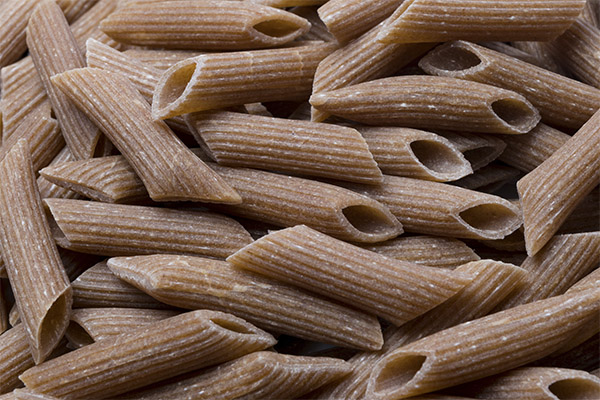
In addition to being environmentally friendly, spelt has a high nutritional value. There are 361 kcal per 100 g of grain, and the ratio of proteins, fats, and carbohydrates is presented in culture as 16.9/2.4/68 g.
Spelt pasta can be distinguished by its teal color. Also, when buying such products in the store, you should pay attention to the expiration date. Spelt products can be stored in their original form for up to 2 years, after which they begin to lose their visual appeal.
This product is useful because the protein that comes from it is easily digested by the body. In addition, in the processing of spelt almost all the important substances are preserved, so pasta from such flour is useful.
Is buckwheat flour pasta useful?
Products made of buckwheat flour contain a lot of nutrients and minerals, which are easily absorbed from the digestive tract. Also buckwheat pasta is an easy dish to digest.
Asians, known for their passion for natural foods, consume large quantities of buckwheat noodles, which are made using mostly buckwheat flour with a small percentage of wheat flour added.
Useful properties of pasta made from corn flour
Such products are a great option for people who are gluten intolerant, since this substance is absent in corn pasta.
The product can be recognized by its bright yellow color, which is provided by the content of carotene. Also from the pasta, made from corn flour, comes a lot of macro- and microelements, vitamins.
Due to its composition, corn pasta is able to:
- normalize metabolic processes;
- slow down the process of fermentation;
- stimulate the work of the intestines;
- Strengthen blood vessels and heart tissue.
Is it possible to eat pasta while losing weight
Many nutritionists do not forbid the consumption of pasta during a diet to get rid of excess weight. On the contrary, it is believed that this product can serve as a source of necessary energy.
The main rules of eating pasta when losing weight:
- You should choose products only from durum wheat.
- It is ideal to combine the product with vegetables, a small amount of cheese, seafood, vegetable oils and mushrooms.
- Pasta in boiled form or cooked in a multicooker is allowed.
- Moderate amounts of pasta should be consumed.
- Slightly undercooked variant of cooking is the most optimal for the diet, and it is better not to eat cooked products.
There is a diet with predominantly pasta dishes in the menu. It is called "Mediterranean" and involves eating rice, pasta and bread at certain times. Portions are also limited in volume, in addition it is suggested to introduce more vegetables, fruits, legumes and dairy products into the diet. Of drinks, a small amount of wine is allowed, as well as citrus juices as a snack.
Pasta in Medicine.
Some physiological conditions require strict dietary restrictions, and flour products are not always allowed. You should also think carefully about your diet if there is a medical condition, especially if it is exacerbated.
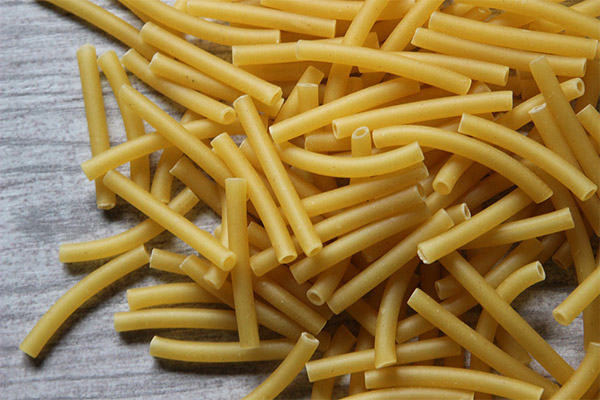
In Diabetes Mellitus.
The stimulating effect of pasta on the digestive organs for people suffering from diabetes is desirable. But with such a disease, you should choose the right products, giving preference to a whole-grain product. On the shelves of stores there are mostly pasta products made of soft wheat or from a mixture, so their benefit for the sick person is questionable. However, diabetics are not prohibited from this product. Doctors only stipulate that their consumption should be limited and not allow them to exceed the daily rate.
For people with type 1 diabetes, moderate doses of carbohydrates from pasta are mostly beneficial. The effect of this product on patients with type 2 diabetes is not fully understood.
Important: Pasta has a glycemic index of 20 to 65 units.
In pancreatitis.
Patients with problems in the functioning of the pancreas should refrain from eating pasta from white flour of the highest grade, because in them this product can cause endocrine disorders. Products of higher quality, from durum or whole grain, can also provoke additional health problems. This is because the increased amount of fiber stimulates the secretion of bile and increases inflammation of the pancreas, as well as provoking diarrhea and painful bowel contractions.
During remission, patients with pancreatitis are allowed to eat well-cooked pasta with the addition of a small amount of vegetable oil. Fried or spicy dishes based on this product can cause the disease to progress to an acute stage.
Gastritis
The consumption of any kind of pasta is allowed for gastritis. Fiber excreted from these products coats the walls of the stomach and promotes normal digestion.
When the disease can be prepared pasta casseroles and soups with the addition of milk. The use of hot sauces and frying should be avoided.
Dietitians recommend that dietitians who have gastritis prefer spaghetti, cones, feathers or vermicelli. The small size of such products is the least likely to traumatize the mucous membrane of the stomach.
For constipation
If there is a problem with defecation, you should eat only whole grain products. Pasta made of buckwheat or spelt flour is also suitable. Products made of these raw materials have a laxative effect and improve intestinal peristalsis.
With gout
Consumption of products with a low glycemic index, which may include pasta from durum wheat, as well as from other cereals, is allowed. White wheat flour, as well as all products made from it, should be abandoned.
In colitis.
The diet in this disease involves a strict abstinence from dishes that have a high fiber content. Therefore, pasta in any form is prohibited. Eating them can aggravate the manifestations of colitis, since the inflamed large intestine accumulates fiber from this product, thereby intensifying the chronic course of the disease.
In hemorrhoids
Flour products, which in this case can include pasta from white wheat flour, cause increased gas formation in the intestinal sections along with legumes and cabbage. Therefore, in the case of hemorrhagic problems, it is better to give up pasta.
In cholecystitis.
In this disease, whole grain pasta is allowed in the diet. Other types of products are better to exclude from the menu.
In case of poisoning
In the first few days after intoxication, pasta should be completely excluded from the diet.
Harms and contraindications
Pasta made from ordinary flour has the lowest nutritional value, because such a product is high in starch and low in useful fiber. These products can cause harm to people with diseases in which this composition of the product is not allowed, such as diabetes.
Hard pasta can be harmful only if consumed in excess, especially in combination with meat dishes and foods high in fat, which is associated with possible difficulties in digestion. For the same reasons it is better to postpone consumption of pasta in the morning.
How to choose and keep the pasta
The choice of product in the store directly affects the nutritional value of the dish that will get to the dinner table.

It is possible to distinguish quality pasta by the following signs:
- Color from golden yellow to creamy.
- Smooth surface.
- Absence of crumbs or foreign flecks in the package.
- Acceptable ingredients in the composition - eggs, water, flour, and dyes, including dill, spinach, and beet.
The low-proof product also has its own distinctive characteristics:
- The rough surface of the pasta.
- A pale hue of the product all the way to white.
- Flour and crumbs at the bottom of the package.
- Broken integrity of the package - it's more likely a transportation defect, but such a package is definitely not worth buying, since the products inside it with a high degree of probability had time to absorb moisture from the environment and lost their nutritional value.
Can I Freeze
Pasta can be used to make semi-finished products. However, only boiled products should be frozen. At the same time, you can cook it to a semi-solid state.
For freezing, you can use bags, plastic containers or food film. Noodles or spaghetti is convenient to freeze in the form of portioned nests, and the smaller varieties of pasta should be distributed evenly in a container or inside a package, greasing each layer with vegetable oil.
How to Eat Pasta
Consuming this product, you should keep in mind the norm, which is 200 g per day. Pasta is most often used as a side dish, but it is not uncommon to use it in soups.
Spaghetti is the most common way to eat pasta. The correct way to eat spaghetti is with the fork in the right hand, helping yourself with the left hand, which should hold a tablespoon. Then the sauce will not slip off the pasta.
How Often Can You Eat?
In moderation in portion sizes, daily consumption of pasta is allowed. However, it should be taken into account that the absorption of bread and high-fat meat at the same time aggravates the dish and negatively affects the digestive function of the body.
Is it possible to eat at night
Surprisingly, under certain conditions, you can eat pasta at night. This applies to useful whole-grain products, which should be slightly undercooked. Many nutritionists agree that a late dinner of such pasta is much healthier than an overnight fast.
What pasta can be combined with
Many of the sauces that traditionally accompany pasta dishes, such as pesto, carbonara and tomato, enhance the classic taste of the floury product. The most compatible foods with pasta are:
- vegetables;
- seafood, particularly tuna, pink salmon and salmon;
- ground meat;
- chicken fillet;
- hard cheese.
It is not recommended to dress dishes with fatty sauces with meat, because the benefits of their use are reduced.
How to cook pasta properly
It is preferable to use a saucepan with a thick bottom for cooking. The important thing is to add salt as soon as the water starts to boil.

So, the steps for the proper cooking of pasta are as follows:
- Boil water in a pot, taken 1 liter for each 100 g of solid product.
- After boiling, salt the water.
- Pour in the pasta.
- Cook on low heat, stirring all the time.
- Remove the pasta to a colander and let the excess liquid drain off. There is no need to rinse them, because it loses most of the nutrients.
With minced meat
To prepare a classic dish with minced meat you will need:
- ground beef (600 g);
- pasta (300 g);
- tomato paste (2 tablespoons)
- onion (1 pc.)
- garlic (2 cloves);
- salt (to taste);
- vegetable oil (2 tablespoons).
Boil the pasta, prepare the sauce. To do this, chop the onion, fry it in a pan until light golden color, and then add to it the minced meat, salt and season to taste. Fry until tender, stirring occasionally. Then crush the garlic and finely chop it and add to the cooked mince. Add tomato paste and mix. Put the sauce on top of the pasta when you want to serve it.
With cheese
The variant of serving with cheese is a favorite dish of Italians, which is allowed to include in the diet even nursing mothers a month after the birth of the baby.
Grate hard cheese on freshly cooked macaroni and sprinkle herbs on top. Parmesan cheese is considered traditional for this dish.
With stew
This cooking option is quite simple. To the boiled pasta you need to add the heated stew. The whole mass is mixed and distributed in portions.
With vegetables
Pasta is excellent with various vegetables, and you can use both fresh and frozen.
The vegetables for the dish should be cooked separately, pre-cooked. Onions and carrots need to be fried before stewing. Garlic loses its spice with temperature treatment, but gives a unique flavor and aroma to the mixture. You can add cream or tomato paste at the end of cooking, this will enhance the taste of vegetables and pasta in the finished dish.
With mushrooms
For cooking you will need:
- pasta (300 g);
- champignons (500 gr);
- sour cream (2 tablespoons);
- Hard cheese (80 g);
- onion (1 pc);
- butter (50 g);
- spices and salt (to taste);
- Greens (optional).
Boil the pasta. Wash the mushrooms under cold running water, cut into slices. Old mushroom stalks can be removed. Chopped onions fry in a frying pan with oil, then add the mushrooms and fry too. Salt the mushrooms at the end of frying. Then take the pan off the fire, add the sour cream and herbs, and stir it up.
On a plate, place a portion of pasta, then mushrooms, not forgetting to pour the resulting sour cream sauce, and then grate the cheese, using a fine grater.
The specified number of ingredients is enough for 4 servings. The dish should be served hot.
How to boil it
The subtleties of cooking pasta depend on the variety. Recommendations for each specific case can be found on the packaging. There is also indicated the optimal cooking time of the product.
Keep in mind that, remaining hot after cooking, the pasta "finish", so you should cook it to a semi-solid state, so as not to get at the output of a diluted mass.
How to cook it in a multicooker
For this dish you need:
- small pasta (400 g);
- Chicken or low-fat home-made minced meat (300 g)
- carrot (1 pc)
- onion (0.5 pcs.)
- water (1.5 l);
- salt (to taste);
- herbs (bunch).
Pouring water into the multicooker, find the program called "Pasta" and select it. Set the timer for 15 minutes. Before the water boils, chop carrots and onions, and when this happens, send them to the machine along with pasta and minced meat. The mass should be salted and stirred. Then start the cooking process again.
Serve the dish, decorating it with herbs.
How to cook in the oven
Pasta is quite a popular dish, which is easy to prepare. You will need an oven heated to 180⁰C.
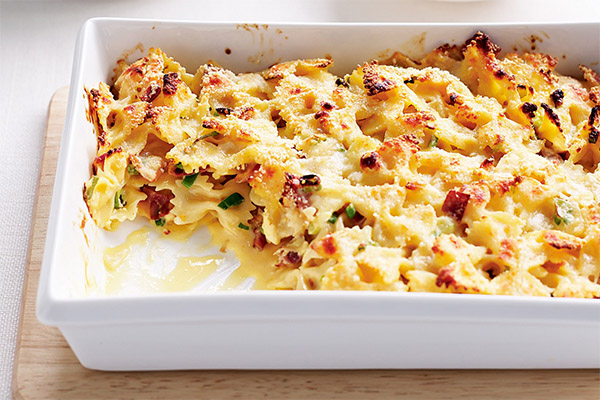
Components of the dish:
- Noodles or other long pasta (220 g);
- eggs (3 eggs); - milk (1 cup)
- milk (1 cup);
- Spices and salt (to taste).
Boil the pasta. At the same time, prepare the mixture for the casserole. To do this, beat the eggs with salt and spices, pour the milk. Mix until homogeneous. Toss boiled pasta in a colander and put it into a baking dish. Pour the filling mixture into the mold so that the egg mixture completely covers the pasta. If there is not enough, use more eggs.
Bake the pasta for about 20 minutes, cut into small pie-like pieces and serve.
This dish can be varied at your discretion with vegetables, any kind of meat, mushrooms. But you should introduce additional ingredients fully or half-ready (for example, in the case of adding meat).
Can I fry
Roast pasta can be not only after boiling, but also completely cooked in a pan from the raw state.
For cooking, you will need:
- pasta (350 g);
- seasonings (to taste);
- vegetable oil (1 tbsp.)
- any sauce (about 80 g)
- onions (1 pc);
- Any fillings (meat, sausage, cheese, stew, vegetables, eggs - as you wish).
Put a large skillet on medium heat and heat it up. Add the oil, chopped onion, a mixture of your favorite spices and additional ingredients (if desired). Stir in the pasta and add a glass of water. Cook over low heat while stirring constantly. After a few minutes of pasta cooking, add sauce (such as ketchup) to the mixture. The full cooking time takes about 10 minutes. At the end of the process, you can add cheese and fresh vegetables as desired, as well as herbs.
Do you need to rinse the pasta after cooking
Many cooks emphasize that you should never rinse pasta after cooking. This is due to the fact that the flow of water from the surface of the product is washed away starch, which is involved in the formation of a subtle flavor in contact with the sauce. By the way, Italians never wash pasta.
How to make pasta at home
To make pasta with your own hands you will need flour (200 g), eggs (2 pcs.) and salt. This amount of ingredients is enough for a dinner for 4 people.
In some stores you can find a special flour "Typo 00", which is a product of durum wheat finely ground and is used by Italian cooks in the preparation of pasta.
Sift the flour, beat the eggs, add salt and knead the dough with a fork and then with your hands. Ready dough should not stick to your hands. Additional flour and eggs may be needed when kneading.
Knead the dough vigorously, and when it is round, form it into a ball, which should then be allowed to stand covered.
Divide the dough into several equal parts, each of which should be rolled into a rectangle and then cut into paste. The width and length of the strips may vary depending on the type of pasta to be obtained. Rolling and slicing will also require extra flour to sprinkle over the contact surfaces of the dough. Next, the pasta should be dried on a sheet of parchment or paper towel sprinkled with flour and then placed in the freezer.
Can pets be given pasta?
Different breeds of cats and dogs may react differently to pasta. But most often veterinarians recommend refraining from this product in the pet's diet, because the animal's body reacts to pasta with increased gassiness. This can lead to pain in the animal.
Interesting facts about pasta
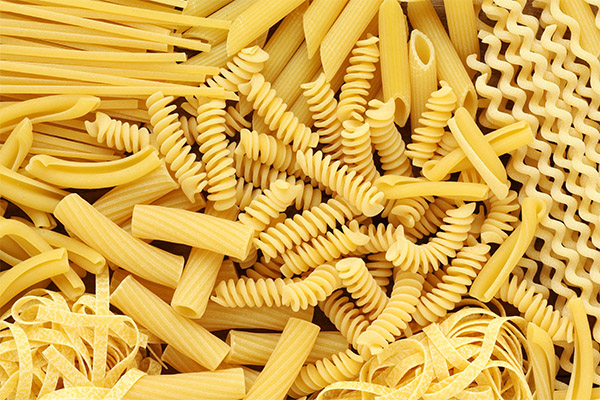
- There is one of the legends of the origin of the name of pasta in the 16th century. The authorship is attributed to Marco Aroni, the owner of the tavern, in which the first pieces of dough rolled up into a tube were prepared. Legend has it that Aroni's daughter invented the new form of noodles by playing with the dough.
- Other sources claim that the name of the dish came from a word from the Sicilian or Greek language.
- It is known that at the time of Marco Polo's explorer, China and Italy already knew and appreciated the taste of pasta.
- Some archaeologists who excavated ancient Etruscan tombs linked the purpose of the mysterious needles found among the utensils to pasta making. But no documentation of this theory has been found.
- With the introduction of dry pasta technology, it began to spread around the globe as it became possible to store it for a longer time and transport it on ships.
Surprisingly, pasta was originally part of desserts and dishes for large celebrations.
The first pasta factory in Russia was opened in the 18th century. Since then, technology has evolved and automated, and today you can find many varieties of pasta widely available.
«Important: all the information on the site is provided for informational purposes only information on this site is for educational purposes only. Before applying any recommendations, consult a specialist. specialist. Neither the editors nor the authors shall be liable for any possible harm caused by materials."


